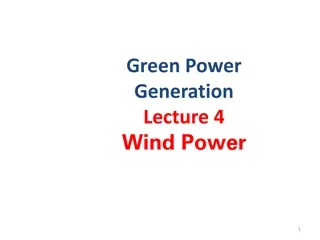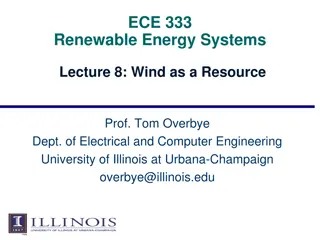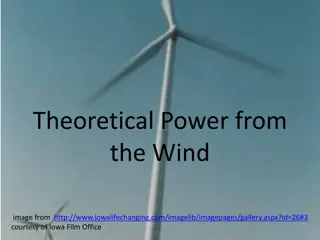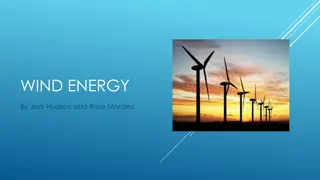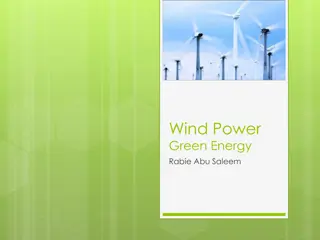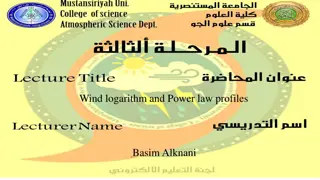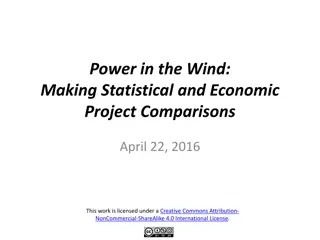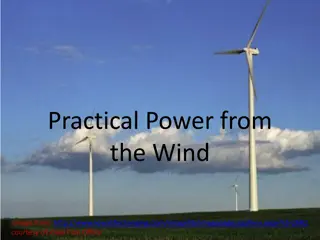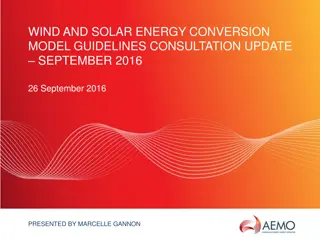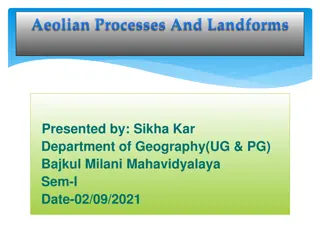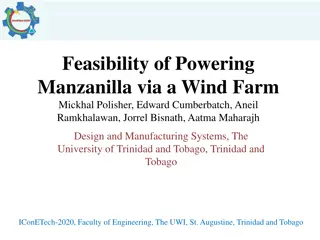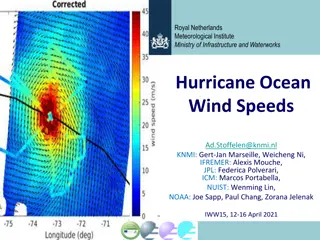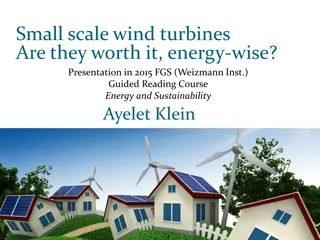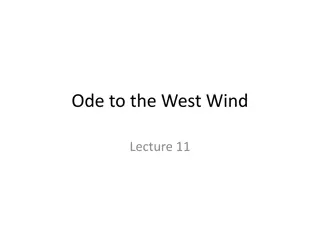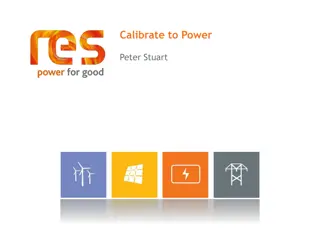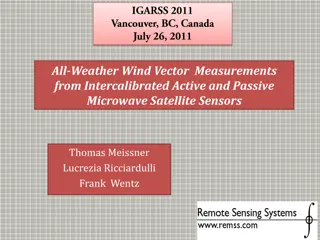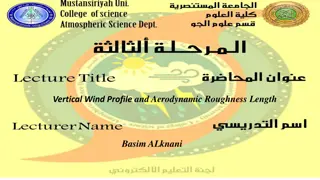Challenges and Solutions in Wind Power Integration Workshop
This workshop delves into the challenges and solutions of large-scale wind power integration, covering topics like grid capabilities, economic value of energy storage, and spatial-temporal aspects. Discussions include wind power perceptions, specific issues, and strategies for accommodating higher levels of variable generation in the energy sector.
Download Presentation

Please find below an Image/Link to download the presentation.
The content on the website is provided AS IS for your information and personal use only. It may not be sold, licensed, or shared on other websites without obtaining consent from the author. Download presentation by click this link. If you encounter any issues during the download, it is possible that the publisher has removed the file from their server.
E N D
Presentation Transcript
Challenge of Large Scale Wind Power Integration - Introduction to the Workshop Pradeep Perera Principal Energy Specialist Asian Development Bank
Workshop Objectives Wind power has the highest penetration level and most rapidly growing among renewable energy technology. Installed capacity of wind power is approximately 300 GW. Asia account for one third and China for one fourth. India is among the top five wind developers in India. Wind power accounts for more than 7- 8 % of installed generation capacity in China and India. Other Asian countries have initiated incentive programs and are on the verge of rapid expansion of wind industry
Workshop Objectives Increasing levels of wind power ( more than 5% of energy and 10% of capacity) poses several technical challenges to power utilities. However, wind power penetration levels of over 30% have been achieved. How are the capabilities of grid analyzed with regards to ability to accommodate various levels of variable generation? What kinds of solutions can be used to accommodate higher levels of variable generation?
Wind Power : Perceptions & Mythes Wind power increases the variability of the power system and may result in large fluctuations in the net demand. ( Consumer demand wind output). This requires balancing generation and higher level of spinning reserve. The thermal plants may have to be operated below their rated output and at lower than maximum efficiency levels. Efficiency penalty can be as high as 20%. There should be mechanism for compensating the utilities and conventional generators for this additional cost.
Specific Issues with Wind Power Integration Increasing levels of wind penetration may increase the economic value of energy storage. Energy storage may not be required up to 20% of wind power penetration levels. Value of storage is in the range of $ 1,000 - $ 1,600 / KW) depending on the generation mix of the system. Higher levels of wind power penetration requires additional investments in network infrastructure and higher operational expenses. Wind Power penetration levels of 25% of average annual energy and 50% of instantaneous power output can be achieved at a acceptable cost.
Specific Issues with Wind Power Integration
Spatial & Temporal Aspects of Wind Power Integration
Energy & Capacity Adequacy The Power System must have adequate generation capacity to meet the demand at all times. Probabilistic methods have to be used to compute the firm generation capacity of wind power plants due to the intermittency. This depend on the correlation of the wind power output and peak demand. Firm capacity of wind power is usually about 10% of the name plate capacity. The contribution of Wind power to energy adequacy ( TWh) is much greater than its contribution to capacity adequacy. If wind power is replacing conventional plants, more wind capacity than the replaced conventional plant is required to maintain the same level of reliability
Grid Planning & Grid adequacy Ability to deliver energy generated to demand centers subject to N-1 contingency requirement. Wind power is usually located far from load centers and at the end of transmission network. Some times wind plants are connected to medium voltage network. Wind plants have a shorter construction time than the time taken to build new transmission lines. Transmission planning need to take into account this to avoid delays in connecting newly built wind plants. Wind plants may alter the power flows in the network and may cause over loading of certain lines and substations. Load flow analysis need to be undertaken to identify potential bottlenecks and network need to be augmented if necessary. Smart Grid technologies and FACT Devices ( Power Electronic ) can be used to address this issue.
Balancing Generation Requirement Higher wind penetration levels result in bigger fluctuation in net demand and require larger amount of balancing generation capacity. Balancing generation capacity is provided by power plants which are capable of rapidly changing their output ( ramping) and fast start up. ( gas turbines & hydro)
Balancing Generation Requirement Fluctuations in wind turbine output are smoothed out when large number of turbines are aggregated as a wind power plants ( from seconds to minutes) and as wind power basins of > 1 GW ( from minutes to hours) . Balancing generation is provided by ; Automatic Generation Control (AGC) { minutes} Dispatching & Load Following { 30 minutes to hours } Short term capacity contracting { day ahead } Wind power prediction can reduce the balancing generation requirement at more than 30 minutes. Balancing generation requirement is usually about 20% of wind power capacity and about 5% should be provided by AGC.
Voltage Control Reactive power supply at key points of the transmission network is required to maintain the voltage profile within acceptable values. Wind plants has limited capability of providing reactive power and voltage support compared to conventional thermal plants. Additional reactive power sources ( i.e. static VAR compensators) may be required for systems with high wind penetration. Some of the conventional plants may have to be operated as reactive power sources even when they are not providing active power.
Power System Security & Wind Penetration Power system security is ability to regain the steady state when subjected to a disturbance such as tripping of major power plant. Higher levels of wind power penetration contributes to enhanced power system stability / security concerns as wind turbines have limited capabilities for grid support compared to conventional power plants.
Transient Stability & Wind power penetration Most of the old wind turbines ( fixed speed induction generators) are designed to trip when there is a network fault. These types of wind turbines do not contribute to post fault recovery and make it even more difficult as absorb additional reactive power during a fault causing voltage collapse. Grid codes now require wind turbines to have Fault Ride Through (FTR) capability. In addition wind turbines may be required to be capable of providing reactive power just as conventional power plants.
Frequency Response & Wind Power penetration Frequency response is usually the ability to respond to changes in frequency within in few msec. to regain the rated frequency and also regain the frequency after subject to a major disturbance. This is distinct from balancing which is primarily load following capability. Frequency response is provided by the governor control and uses the kinetic energy stored in the rotating system of generators to alter the active power output to regain demand supply balance. Wind turbines have lower inertia and has limited ability to supply frequency response compared to conventional power plants. This is more acute in small island systems.
Workshop Agenda The first session : The status of and approaches adopted by countries with high wind power installations: China, USA, India and Australia. The second session : Long-term strategic system-wide analysis to determine the requirements in order to achieve higher penetration of variable generation. What is the acceptable level of penetration of wind power into a grid? What factors determine the level of penetration ? Why are some grids able to absorb higher percentage of energy from wind? How can the level of penetration of wind power be increased? What is the cost of higher levels of penetration of wind?
Workshop Agenda The third session : Grid code for interconnecting variable generation. Gird codes in USA and China will be summarized. What are the requirements to make wind power plants grid friendly? What power quality issues must be addressed by wind energy? What types of data should the wind plants provide to dispatch center The fourth session : System impact studies of wind power. the impact on reliability, safety and stability of the power system What is the impact on system stability due to wind power? What is the impact of rapid ramping up or down of wind energy generation on the grid? How is the power flow in a grid impacted with high wind energy production and low demand? What changes must be made to the grid to accommodate wind energy?
Workshop Agenda The fifth session : Dispatching of Wind Power. Is wind energy dis patchable? What methods are used by grid operators to schedule wind into in 24-hour, and hour-to-hour time window? How well can wind energy be forecasted? How much spinning reserves are needed to support variability of wind energy? The sixth session,: emerging technologies and methods related to integrating variable generation into the grid will be presented. Role of storage technologies, wind energy forecasting and advances in control technologies will be discussed in this session.


